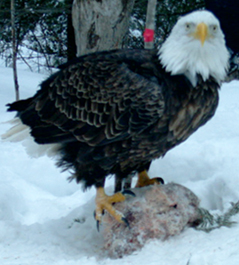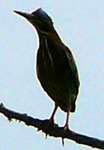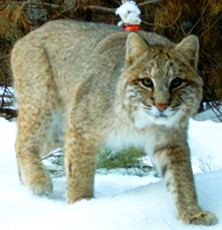Wetlands, Wildlife, and Habitat
 Breeding bird surveys were conducted during spring of 2007 (33 site visits), 2008 (28 site visits) and 2009 (59 site visits). A total 137 species of birds were detected during 124 total site visits to the 28 wetland study areas. Over 1,500 acres encompassing 28 wetland complexes were inventoried on the reservation. Wildlife inventory methods included remote camera surveys with specific lures and mammal track/sign data collection throughout the reservation.
Breeding bird surveys were conducted during spring of 2007 (33 site visits), 2008 (28 site visits) and 2009 (59 site visits). A total 137 species of birds were detected during 124 total site visits to the 28 wetland study areas. Over 1,500 acres encompassing 28 wetland complexes were inventoried on the reservation. Wildlife inventory methods included remote camera surveys with specific lures and mammal track/sign data collection throughout the reservation.
Seventeen species were targeted and 15 of the 17 were detected with the cameras and track/sign surveys in addition to several non-target species (white-tailed deer, porcupine, skunk, birds). Approximately 350 plant species were identified from 207 vegetation plots sampled. A total 135 species of birds were detected from 132 site visits. Surveys for plants and birds identified rare, threatened and/or species of special concern. Wildlife habitat data including volume of coarse woody debris, snags per acre, percent canopy cover, and basal area of trees are also being collected at the 250 plots within the sites. The wetland portion of the wildlife and habitat inventory was finalized in summer 2011.
Wetland Wildlife and Habitat Survey Report
Bird Species Detected
 Breeding bird surveys were conducted during spring of 2007 (33 site visits), 2008 (28 site visits) and 2009 (59 site visits). A total 137 species of birds were detected during 124 total site visits to the 28 wetland study areas. Click here for pdf document - Bird Species detected in 28 wetland sites on the KBIC L'Anse Reservation.
Breeding bird surveys were conducted during spring of 2007 (33 site visits), 2008 (28 site visits) and 2009 (59 site visits). A total 137 species of birds were detected during 124 total site visits to the 28 wetland study areas. Click here for pdf document - Bird Species detected in 28 wetland sites on the KBIC L'Anse Reservation.
Species of threatened and/or species of special concern detected during the bird surveys were: Trumpeter swan (Cygnus bucinnator) (n=3), common loon (Gavia immer) (n=2), bald eagle (Haliaetus leucocephalus) (n=21), American bittern (Botoraurus lentiginosus) (n=6), northern harrier (Circus cyaneus) (n=6), marsh wren (Cistothorus palustris) (n=12), and golden-winged warbler (Vermivora chrysoptera) (n=5).
Mammals detected
Cuddeback infrared cameras were used for remote camera studies and baited with meat scraps and a long-distance scented lure. There were eighteen target species identified for the survey: wolf, coyote, gray and red fox, beaver, bobcat, cougar, lynx, black bear, fisher, pine marten, mink, muskrat, weasel species, badger, otter, raccoon, moose and snowshoe hare (due to the importance as prey for lynx). Sixteen of the 18 target species were detected with the cameras and track/sign in addition to several non-target species (white-tailed deer, porcupine, skunk, birds). Cougar and lynx were the two target species that were not detected at any of the 28 total wetland sites between 2006 and 2009.
infrared cameras were used for remote camera studies and baited with meat scraps and a long-distance scented lure. There were eighteen target species identified for the survey: wolf, coyote, gray and red fox, beaver, bobcat, cougar, lynx, black bear, fisher, pine marten, mink, muskrat, weasel species, badger, otter, raccoon, moose and snowshoe hare (due to the importance as prey for lynx). Sixteen of the 18 target species were detected with the cameras and track/sign in addition to several non-target species (white-tailed deer, porcupine, skunk, birds). Cougar and lynx were the two target species that were not detected at any of the 28 total wetland sites between 2006 and 2009.
Number of detections (animals detected based on 24 hour time periods) per target species and method of detection, 2006 through 2009 from 28 study areas.
| Target Species (Ojibwe name) | Detected by Track/Sign |
Detected by Observation |
Detected by Remote Camera |
Total |
| Wolf (ma'iingan) | 35 | 0 | 9 | 44 |
| Coyote | 55 | 6 | 49 | 110 |
| Fox Species(waagoosh) | 17 | 1 | 11 | 29 |
| Bobcat (gidagaa-bizhiw) | 15 | 0 | 3 | 18 |
| Cougar (mishibizhii) | 0 | 0 | 0 | 0 |
| Lynx (bezhiw) | 0 | 0 | 0 | 0 |
| Otter (nigig) | 10 | 4 | 5 | 19 |
| Fisher (ojiig) | 10 | 2 | 36 | 48 |
| Pine Marten | 5 | 1 | 13 | 19 |
| Mink (zhaangweshi) | 13 | 3 | 2 | 18 |
| Weasel Species (zhingos) | 5 | 0 | 13 | 18 |
| Badger (misakokojiish) | 7 | 0 | 0 | 7 |
| Beaver (amik) | 24 | 8 | 0 | 32 |
| Muskrat (wazhask) | 7 | 3 | 0 | 10 |
| Raccoon (esiban) | 11 | 4 | 114 | 129 |
| Black Bear (makwa) | 46 | 8 | 98 | 152 |
| Moose (mooz) | 5 | 2 | 1 | 8 |
| Snow Shoe Hare (waabooz) | 19 | 3 | 71 | 93 |
| Total | 281 | 45 | 428 | 754 |
